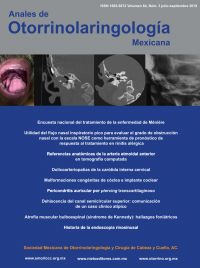
Auricular perichondritis due to transcartilaginous piercing.
An Orl Mex. 2019 julio-septiembre;64(3):112-117.
Erik Narvaez-Hernández,1 Ofelia Candolfi-Arballo,2 Marlet Nuño-Rodríguez3
1 Otorrinolaringólogo.
2 Maestra en Ciencias, bióloga.
3 Estudiante de quinto año de la licenciatura en Medicina.
Universidad Autónoma de Baja California, Unidad Valle de las Palmas, Escuela de Ciencias de la Salud, Tijuana, Baja California, México.
Resumen
OBJETIVO: Describir las características de la pericondritis causada por perforación en el cartílago del pabellón auricular y el tratamiento antibiótico adecuado.
MATERIAL Y MÉTODO: Estudio retrospectivo, descriptivo, observacional y transversal de casos de pericondritis diagnosticados en la consulta externa de Otorrinolaringología de noviembre 2015 a diciembre de 2017.
RESULTADOS: Se analizaron 11 casos de pericondritis ocasionada por perforación transcartilaginosa en el pabellón auricular. Las causas más frecuentes fueron de tipo bacteriano por Pseudomonas aeruginosa y Staphylococcus aureus resistente a meticilina (SARM).
CONCLUSIONES: La pericondritis se reporta mayormente en mujeres jóvenes, que acuden nuevamente al lugar en el que se realizaron la perforación en busca de solución, donde reciben información inadecuada, lo que prolonga y complica aún más la infección. Es necesario conocer el tratamiento adecuado para evitar complicaciones en un procedimiento estético cada vez más frecuente.
PALABRAS CLAVE: Pericondritis; cartílago; infección bacteriana; Pseudomonas aeruginosa; Staphylococcus aureus resistente a meticilina.
Abstract
OBJECTIVE: To describe the characteristics of perichondritis caused by piercing in the cartilage of the auricular pavilion and the proper antibiotic treatment.
MATERIAL AND METHOD: A retrospective, descriptive, observational and cross-sectional study of the cases of perichondritis diagnosed in otolaryngology outpatient clinic from November 2015 to December 2017 was carried out.
RESULTS: We analyzed 11 cases of perichondritis caused by transcartilaginous piercing in the auricular pavilion. The most frequent etiologies were bacterial type due to Pseudomonas aeruginosa and methicillin resistant Staphylococcus aureus (MRSA).
CONCLUSIONS: Perichondritis is reported more frequently in young women, who assist again to the place were piercing was done searching for a solution, where they receive inadequate information, prolonging and complication even more the infection. It is necessary to know the adequate treatment to avoid complications of greater severity.
KEYWORDS: Perichondritis; Cartilage; Bacterial infection; Pseudomonas aeruginosa; methicillin resistant Staphylococcus aureus.

